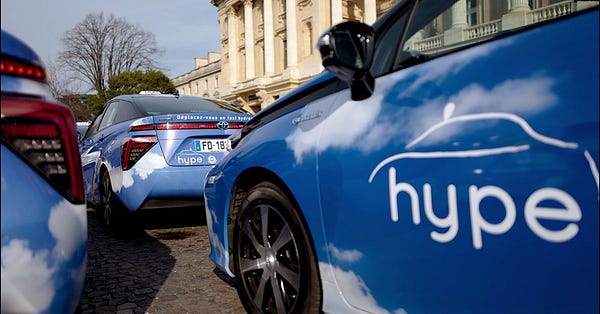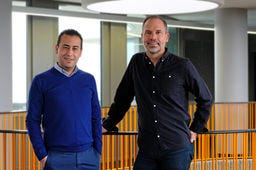Seed Funding: How Frst Invests And Encourages Bigger Risks
Co-founders Pierre Entremont and Bruno Raillard see a Seed gap in France they want to plug.
Frst in many ways is a typical Seed fund. Which is the point. Co-founded by Bruno Raillard and Pierre Entremont in 2015, the firm aims to replicate in France the classic Seed funding playbook from Silicon Valley. Expanded Seed funding, the duo believes, is essential for allowing more French entrepreneurs to take even bigger risks.
If the firm’s methods are classic, its journey is not. It started at the time as an investment wing of Otium Capital, which had been founded by Pierre-Edouard Stérin, the French entrepreneur known for Smartbox, a gift box service. Stérin started Otium in 2007, and 8 years later developed an itch to back startups.
So he hired Raillard and Entremont to start Otium Ventures. Stérin backed the fund with €40 million and became its sole LP. Raillard said he was intrigued by the prospect because he could see the French ecosystem starting to gain momentum. But there was a critical lack of homegrown funding.
“It gave the sensation at this time that was a new generation of French founders that were building great companies from France that were having the commitment, technical skills, and ambition to build global-scale companies,” he said. “And there was a mismatch between those people and the investor scene in France.”
There was no need to reinvent the wheel. With the ecosystem so young, the Seed stage seemed to be a logical place to start. So they studied the strategies of U.S. Seed funds and got to work. They particularly admired Benchmark and First Round.
“We felt there was a great possibility to match this type of ambition and to have the right level of aggressiveness, optimism, and the capacity to project companies forward by essentially doing what has been the VC playbook for decades in the U.S.,” he said.
Entremont added: “The playbook we applied was basically to study the best U.S. Seed funds and copy and paste.”
They built a solid track record. Portfolio company PayFit has gone on to raise $101 million. Shippeo has raised $67.9 million. Owkin has raised $72 million.
As they were nearing the end of that fund, they decided it was time to strike out on their own and raise the second fund with outside investors. So in 2019, they spun out and became Frst.
“We realized that our so our insight on the French market was becoming more and more visible to everyone,” Raillard said. “The investments were becoming self-sustaining. So it was time to graduate and become adults and raise our own funds.”
The partners continue to manage the original Otium fund. But they then raised €60 million to launch their second fund. Currently, they are looking to expand that fund size.
For the moment, the LPs for this second fund fall into three categories: public, European money, and French money. So that includes Bbifrance, European institutional funds such as AXA Venture Partners, and then the remaining 20% are entrepreneurs. The latter includes Xavier Niel, the Supercell founders, and a Spotify co-founder.
“They share our belief that the French and the European ecosystems are up and coming and in the coming years will turn out great companies and global scale companies,” Raillard said.
The second fund is still relatively new, and Frst hasn’t disclosed many of its investments yet. But one notable early bet was Pigment, which is reinventing spreadsheets to improve business forecasting. In December, Pigment raised a Series A round of €24.1 million, which included money from London-based Blossom Capital and New York-based FirstMark. At this stage, backing companies that attack notable international investors in later rounds is an important benchmark for Frst’s investment goals.
“Pigment is a great representation of the type of teams we are now seeing more and more in France,” Raillard said. “There is a blend of experienced operators, repeat entrepreneurs, and ambitious people who are unapologetic for being French. They don’t consider that being French prevents them from rubbing shoulders with teams in the U.S. or U.K.”
How Frst Invests
Fundamentally, the mission of Frst’s investment strategy is to support bigger risks by entrepreneurs.
“Historically in France, VCs were very risk-averse because the LPs asked them to be risk-averse,” Entremont said. “The LPs were tax optimized vehicles or public money or corporates. And these types of LPs don’t like risk. All they want you to do is return 1X the money invested. This is why VCs have been cautious.”
Relatively speaking, if Frst invests in 30 companies, it’s betting that 2 or 3 will be winners while the rest will likely die. But under the more conservative model, French VCs might look for 28 companies that do okay, and maybe one that does a little better.
“It changes everything,” Entremont said. “Because you don't behave the same way when you want to have three mega winners and 25 companies that will return significant money. In France, VCs used to say that having a company worth €100 million is a success and this motto has been intoxicating the system for years. Now in France, there are companies that have the strong potential to be someday worth billions, which wasn’t the case previously.”
Hatching a billion euro company, however, means pursuing bigger ideas at the start and taking bigger risks. So how does Frst find those companies and entrepreneurs?
It starts with a few guidelines. Frst not only wants to be the first investor, but it also wants to be the investor to even talk to the founder.
To spot these startups at the earliest possible moment, Frst has developed an internal methodology. According to Frst, each year in France there are about 3,000 companies started that look like startups. Frst has a process for compiling that list (which they woulnd’t share of course because secret sauce and all that) but that involves tapping public and private info.
Frst partners and staff review every company on that list looking for various characteristics. Much of this revolves around the identity of the founders, including education, previous work experience, and other activities. That doesn’t mean one has to have attended a major university. An unusual career path, and one that includes time working at other interesting companies, can be just as eye-catching. One investment they did recently involved a CEO who seemed intriguing because of his competitive rowing background.
That helps cull the list to 500. Then they call all 500. Initially, they did this because they had no inbound deal flow five years ago. But the process worked. Even now, when someone refers them to a startup, they have likely already been in contact. As for the founders, they are often shocked to get the call.
“They are very surprised because we are the first people to contact them,” Entremont said. “We say, ‘We saw you are starting a company, and can you tell us a bit more about what you are doing?’ And they often say, ‘How did you know I am starting a company? I haven’t told anyone.’ So we have a quick chat of about 20 minutes and it’s enough to identify if it’s useful to do a meeting.”
From there, that smaller subset leads to about 200 meetings, which in turn leads to an average of 10 investments each year. Their average Seed investment is about €1 million. There’s not a single sector that is a particular focus. Rather, they’re just looking for projects that interest them.
“The way we see the French ecosystem, it produces each year between 10 and 15 high-quality teams out of that 3000,” Entremont said. “We basically boil the ocean to identify those 15 teams.”
While Seed funding has improved in France, the Frst founders would like to see more competition for deals. Currently, Series A funding seems solid, but funding for those earliest stage ideas needs more support.
“We think it would be better for the ecosystem to have a few other funds like us,” Entremont said. “Because it's really fuel for the ecosystem if so many entrepreneurs can try many things with the right amount of money at the right timing in the company’s life. The problem with not having enough funds like us is that it doesn't drive entrepreneurs to take important risks. When you have a firm like us, you have a portfolio strategy. So the question you ask yourself, is not, ‘Will this company work?’ You ask, ‘Does this company have a 10% chance of becoming huge?’ This portfolio strategy allows you to take risks and to invest in unusual funders and unusual models, and do high-risk, high-reward investing. Right now, there is competition for these deals, but it's not super intense. We would like it to be more intense.”
In other news…
Maddyness published an interview this week with Sophie Viger, director of Xavier Niel’s 42 coding school. There were a couple of notable updates that I hadn’t heard before.
First, they now have 33 campuses with a goal of 50 by 2025. That’s impressive. I first visited in 2016, and it seemed ambitious back then to offer free coding education at one school. Clearly, the idea has taken off.
But…
The story also notes that 42 has closed its Silicon Valley campus which apparently was a flop. In explaining why the model didn't work there, Viger had this rather barbed take regarding her predecessors and attitudes in SV:
"They started off...telling themselves that 42 was going to revolutionize everything in the United States, forgetting that there, money is a value in itself. So training that costs zero is also zero in quality for many Americans...So we had a huge building with very few people in it, and all this at staggering costs because Silicon Valley is very expensive…We had to stop the bleeding, and we have therefore moved the training entirely online for the moment and returned the building to stop the charges."
The big picture: This lesson also comes from Viger:
“My predecessors went there without really knowing the territory. However, the presentation of the school and the support of local populations must be adapted to each site.”
That is critical advice for anyone going abroad. Does the product or service need to be adapted in some fashion to local needs and culture? Obvious, maybe. But it seems even people highly experienced in digital trends can think they are immune to this rule. Especially when overall, the model seems to be working.
Venture funding










If you’re enjoying The French Tech Journal, please support the project by forwarding it to friends and sharing it on your social networks. You can comment on this post or by replying to this email. And if you have ideas for stories, tips, or just want to harass me, send me an email: chris@frenchtechjournal.com.





